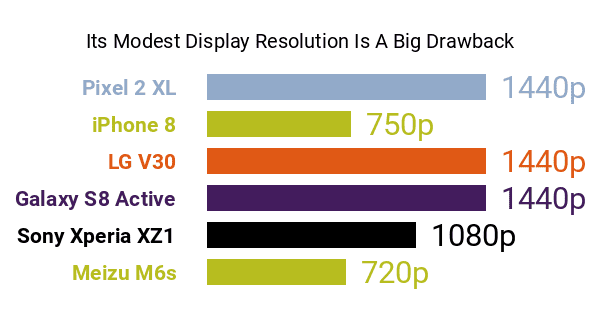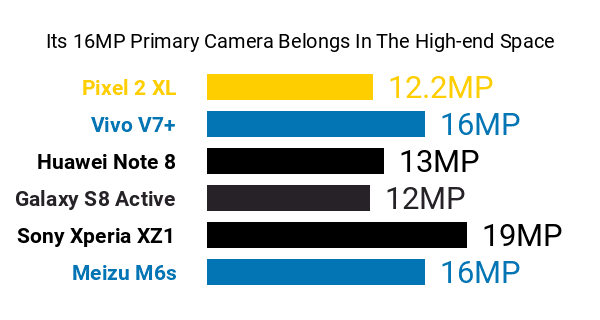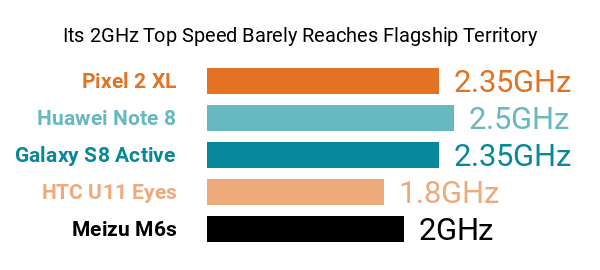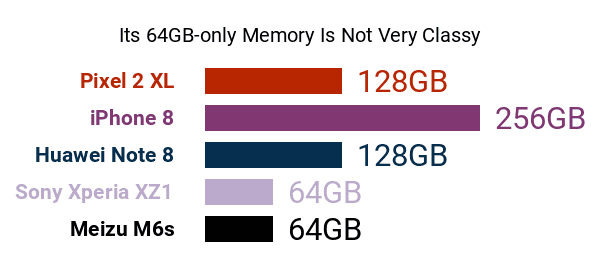- Analysis by KJ David
Debuting early on in 2018, the Meizu M6s is pitched as a refined version of the upmarket M6, featuring a few upgrades (aka pros) here and there. That being said, our shrewd eye for specs still caught some cons along the way.
One of the biggest hitches to its feature set is the fact that it settles for an HD+ (1440 x 720) screen resolution  , despite extending the original M6's 5.2-inch interface to a much-wider 5.7 inches and adapting the trendy (as of this technical review) 18:9 aspect ratio
, despite extending the original M6's 5.2-inch interface to a much-wider 5.7 inches and adapting the trendy (as of this technical review) 18:9 aspect ratio  . In comparison, most models in our list of top-tier phablets tout FHD/FHD+ (1080p) resolutions, with some even shooting for premium-class QHD/QHD+ (1440p) interfaces. Moreover, it does not offer any upgrade in terms of battery power, coming with only 3000mAh
. In comparison, most models in our list of top-tier phablets tout FHD/FHD+ (1080p) resolutions, with some even shooting for premium-class QHD/QHD+ (1440p) interfaces. Moreover, it does not offer any upgrade in terms of battery power, coming with only 3000mAh  (The M6 has a 3070mAh cell), in spite of the aforementioned increase in screen size.
(The M6 has a 3070mAh cell), in spite of the aforementioned increase in screen size.

As for its selling points, the M6s features an on-screen Halo button  , under which resides an mBack pressure sensor. This means that users can interact with the phone using various gestures applied to its pressure-sensitive button. For instance, a light touch brings you to a previous screen/page, a normal press brings up the home screen, and a long press powers the display off. With this pressure-sensing button replacing the M6's physical home key, the M6s's fingerprint scanner
, under which resides an mBack pressure sensor. This means that users can interact with the phone using various gestures applied to its pressure-sensitive button. For instance, a light touch brings you to a previous screen/page, a normal press brings up the home screen, and a long press powers the display off. With this pressure-sensing button replacing the M6's physical home key, the M6s's fingerprint scanner  now resides underneath a notch alongside one of its edges -- Meizu claims that this design feels more natural than front- or rear-mounted fingerprint sensors.
now resides underneath a notch alongside one of its edges -- Meizu claims that this design feels more natural than front- or rear-mounted fingerprint sensors.
While its Halo button sounds fancy, we found nothing angelic about the M6's 8-megapixel selfie camera  , which shies of the selfie cams boasted by some of the best selfie phones on the market. Fortunately, it rocks a respectable 16-megapixel 5P-lens camera with phase-detection autofocus (PDAF) and a dual-tone flash
, which shies of the selfie cams boasted by some of the best selfie phones on the market. Fortunately, it rocks a respectable 16-megapixel 5P-lens camera with phase-detection autofocus (PDAF) and a dual-tone flash  on the opposite side of its metal body.
on the opposite side of its metal body.

Among its hardware pros and cons are an Exynos 7872 hexa-core (dual 2GHz + quad 1.6GHz) processor crafted with the 14nm FinFET process technology  that's heavily-marketed as ideal for high-volume and process-hungry applications. Keep in mind, though, that some of the fastest smartphones peak at 2.5GHz. Its Exynos chip is accompanied by a so-so 3GB RAM and an ARM Mali-G71 graphics processor.
that's heavily-marketed as ideal for high-volume and process-hungry applications. Keep in mind, though, that some of the fastest smartphones peak at 2.5GHz. Its Exynos chip is accompanied by a so-so 3GB RAM and an ARM Mali-G71 graphics processor.

Lastly, it comes with either 64GB or 32GB of memory  expandable by up to 128GB, which sounds oddly-low, since several comparable models start out with 128GB of inbuilt memory and support 256GB microSD cards.
expandable by up to 128GB, which sounds oddly-low, since several comparable models start out with 128GB of inbuilt memory and support 256GB microSD cards.

So, when it comes to pros and cons, this tweaked version of the Meizu M6 could attract high-class smartphone shoppers with its pressure-sensitive Halo button and expansive display, but a higher storage memory and power cap would have given it a heavier punch.





You Should Also Check These Out:
 Full Menu
Full Menu